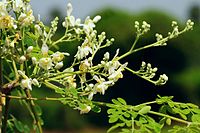
Photo from wikipedia
Abstract Using “greener” processes to treat wastewater has become increasingly popular because these processes are environmentally friendly and offer a wide variety of other benefits, such as reducing costs, reducing… Click to show full abstract
Abstract Using “greener” processes to treat wastewater has become increasingly popular because these processes are environmentally friendly and offer a wide variety of other benefits, such as reducing costs, reducing the generation of by-products, and providing greater biodegradability. In particular, Moringa oleifera (MO) has historically been used as a natural coagulant to treat contaminated effluents and it continues to be used today. This paper is a collection of information related with using MO in contemporary applications, mainly wastewater treatment. It reviews the main active components involved in the processes, the most significant mechanisms identified, seed processing techniques and some practical applications, and the main trends in the field, as well as provides comments and recommendations for further developments and identifies knowledge gaps and future research directions.
Journal Title: Journal of water process engineering
Year Published: 2018
Link to full text (if available)
Share on Social Media: Sign Up to like & get
recommendations!